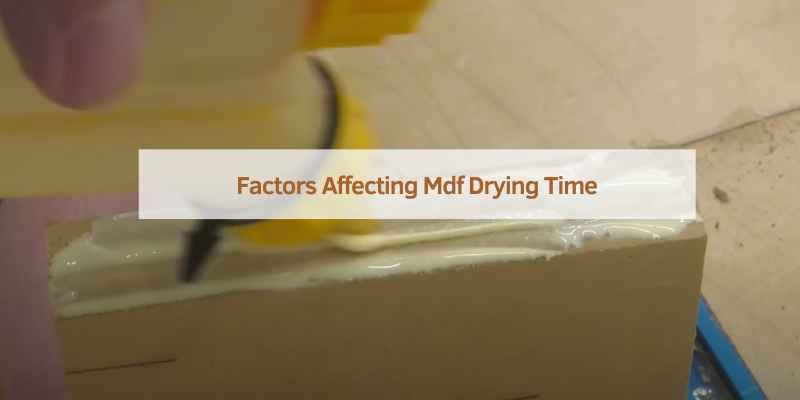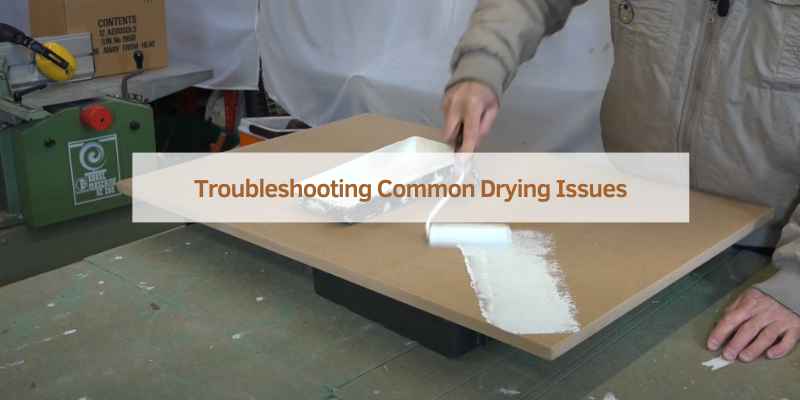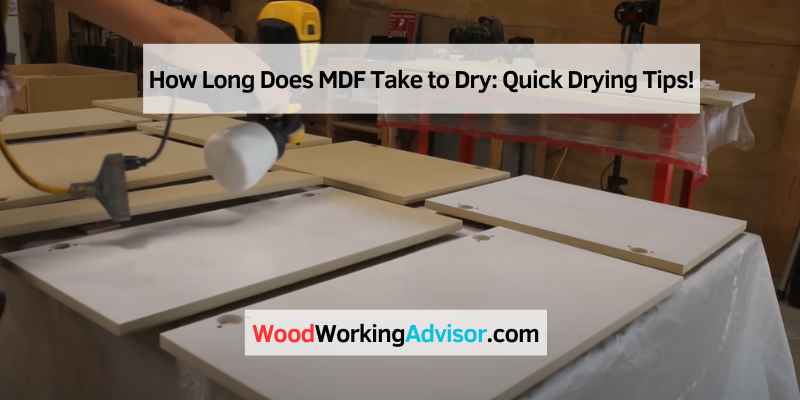MDF typically takes 24-48 hours to dry completely. This depends on humidity and temperature conditions.
Medium-Density Fiberboard (MDF) is widely used in furniture and cabinetry due to its smooth surface and versatility. Proper drying is crucial to ensure durability and prevent warping or swelling. The drying time for MDF varies based on environmental factors such as humidity and temperature.
Ensuring a well-ventilated area can speed up the process. It’s essential to allow MDF to dry fully before painting, sealing, or using it in any project. This ensures the material maintains its integrity and delivers the best performance. Careful attention to drying times can significantly enhance the longevity and quality of your MDF-based projects.
Factors Affecting Mdf Drying Time
Understanding the factors that influence the drying time of MDF (Medium-Density Fiberboard) can help ensure better results in your projects. These factors can vary based on the environment, materials, and methods used.
Material Thickness
The thickness of the MDF board significantly impacts drying time. Thicker MDF boards take longer to dry. Thinner boards dry faster. This is due to the amount of moisture that needs to evaporate.
| Material Thickness | Drying Time |
|---|---|
| 1/4 inch | 1-2 hours |
| 1/2 inch | 3-4 hours |
| 3/4 inch | 5-6 hours |
Environmental Conditions
Temperature and humidity are crucial environmental factors. High temperatures speed up the drying process. High humidity slows it down.
- High Temperature: Faster drying
- Low Temperature: Slower drying
- High Humidity: Slower drying
- Low Humidity: Faster drying
Good ventilation also helps. Air circulation aids in moisture evaporation.
Type Of Adhesive Or Paint
The type of adhesive or paint used can also affect drying time. Water-based products dry faster than oil-based ones. Here is a quick comparison:
| Product Type | Drying Time |
|---|---|
| Water-based adhesive | 1-2 hours |
| Oil-based adhesive | 4-6 hours |
| Water-based paint | 1-2 hours |
| Oil-based paint | 6-8 hours |
Always check the product label for specific drying times. Manufacturer’s instructions provide the most accurate information.

Average Drying Times For Mdf
MDF, or Medium Density Fiberboard, is a popular material for many projects. Knowing how long it takes to dry is important for planning. Different factors affect drying times.
Paint Drying Times
When painting MDF, drying times vary. Several factors like the type of paint and the environment play a role. Here are some common drying times:
- Water-based paint: Dries in 30 minutes to 1 hour.
- Oil-based paint: Takes about 6 to 8 hours to dry.
- Spray paint: Dries in 10 to 20 minutes.
Always check the paint manufacturer’s instructions for exact times.
Adhesive Curing Times
Using adhesives with MDF requires curing time. Different adhesives have different curing times. Here are some examples:
| Adhesive Type | Curing Time |
|---|---|
| White Glue (PVA) | 24 hours |
| Wood Glue | 30 minutes to 1 hour |
| Epoxy | 5 minutes to 24 hours |
Always follow the adhesive instructions for the best results.
Preparation Steps For Efficient Drying
Proper preparation is crucial for MDF (Medium Density Fiberboard) to dry efficiently. Ensuring the surface is ready can speed up drying times and improve the final finish. Below are detailed steps to prepare MDF for drying.
Surface Sanding Techniques
Sanding the MDF surface is essential for a smooth finish. Use a medium-grit sandpaper, around 120-grit, to sand the surface evenly. Ensure you sand in a circular motion to avoid scratches.
After sanding with medium-grit, switch to a finer grit, like 220-grit. This will remove any remaining rough spots and provide a smoother finish. Always sand in a well-ventilated area to avoid inhaling dust particles.
Priming For Better Adhesion
Priming the MDF ensures better paint adhesion and faster drying. Choose a high-quality primer suitable for MDF. Apply a thin, even coat using a paintbrush or roller.
Allow the primer to dry completely. This usually takes around 1-2 hours. Check the manufacturer’s instructions for exact drying times. Once dry, lightly sand the primed surface with fine-grit sandpaper to smooth out any imperfections.
Apply a second coat of primer if necessary. This ensures a uniform and smooth surface, ready for painting. Priming properly can significantly improve the final appearance and durability of your project.
Quick Drying Tips For Mdf
MDF, or Medium Density Fiberboard, is popular for crafting and DIY projects. Drying MDF quickly can save time and effort. Here are some quick drying tips to help you speed up the process.
Improving Air Circulation
Good air circulation helps MDF dry faster. Use fans to keep the air moving around the MDF. Place the MDF in an open area with lots of space. Avoid stacking the MDF boards. This allows air to reach all surfaces.
Open windows and doors to let fresh air in. This will increase ventilation. A dehumidifier can also help by removing moisture from the air. Remember to rotate the MDF pieces frequently. This ensures all sides dry evenly.
Using Accelerators And Catalysts
Accelerators and catalysts can speed up the drying process. These chemicals help the MDF dry faster. Always follow the instructions on the product label.
Mix the accelerator into your paint or primer. This will make the drying time shorter. Be cautious not to use too much. Excessive use can damage the MDF.
Heat guns and hair dryers can also be used. Keep the heat source moving to avoid burning the MDF. Use them on a low setting to prevent damage.
Here is a simple table to summarize the tips:
| Method | Details |
|---|---|
| Air Circulation | Use fans, open windows, avoid stacking |
| Dehumidifier | Removes moisture from the air |
| Accelerators | Mix with paint or primer |
| Heat Guns | Use on low setting, keep moving |
Tools And Equipment For Faster Drying
Drying MDF quickly can be challenging. But, using the right tools and equipment can speed up the process. This section covers the best tools for faster drying.
Fans And Dehumidifiers
Using fans and dehumidifiers can help dry MDF faster. Fans circulate air, which helps remove moisture. Dehumidifiers reduce humidity in the air, making drying faster.
Place a fan near the MDF. Ensure the fan blows directly on the MDF. Use a dehumidifier in the room. This combination works well to dry MDF quickly.
| Tool | Function |
|---|---|
| Fan | Circulates air |
| Dehumidifier | Reduces humidity |
Heat Guns And Lamps
Heat guns and lamps can also speed up drying. Heat guns blow hot air on the MDF. This heat evaporates moisture quickly. Lamps can also help. They provide steady heat to dry MDF.
Be careful with heat guns. They can get very hot. Keep the heat gun moving to avoid burning the MDF. Use lamps for a more gentle drying process.
- Hold the heat gun a few inches from the MDF.
- Move the heat gun back and forth.
- Use a lamp for steady, gentle heat.
Safety Precautions During Drying
Drying MDF (Medium Density Fiberboard) requires taking several safety precautions. Ensuring the safety of yourself and others is paramount. This section outlines critical guidelines to follow.
Ventilation Guidelines
Proper ventilation is crucial during the drying process. Ensure the workspace is well-ventilated to prevent inhaling harmful fumes. Open windows and use fans to maintain airflow.
- Open windows to allow fresh air to circulate.
- Use exhaust fans to remove fumes and dust.
- Avoid drying MDF in confined spaces without ventilation.
Wear a mask to protect yourself from inhaling dust and chemicals. Choose a mask rated for dust and fumes.
Handling And Disposal Of Chemicals
Handle chemicals with care during the drying process. Wear gloves to protect your skin from contact with hazardous substances.
Store chemicals in clearly labeled containers and keep them out of reach of children and pets.
| Safety Measure | Description |
|---|---|
| Wear Protective Gear | Gloves, masks, and safety goggles |
| Proper Storage | Store in labeled, sealed containers |
| Disposal | Follow local regulations for hazardous waste |
Dispose of chemicals according to local regulations. Improper disposal can harm the environment and health.
Troubleshooting Common Drying Issues
Drying MDF can present several challenges. Swelling, warping, and uneven drying are common problems. Understanding and addressing these issues ensures a smooth project.
Dealing With Swelling And Warping
Swelling and warping occur when MDF absorbs too much moisture. Follow these tips to prevent these issues:
- Store MDF in a dry, climate-controlled area.
- Seal the edges with a water-resistant primer.
- Use a dehumidifier in the drying space.
- Ensure proper ventilation to avoid trapped moisture.
If MDF swells or warps, apply weights to flatten it. Leave the weights on until dry. Sand any rough areas to smooth the surface.
Addressing Uneven Drying
Uneven drying leads to inconsistent finishes and structural weaknesses. To avoid this, ensure even air circulation around the MDF. Consider these steps:
- Elevate MDF off the ground with spacers.
- Rotate the MDF periodically.
- Use fans to improve air movement.
Check the MDF for moisture content with a moisture meter. Ensure the reading is consistent across the board before proceeding with finishing.

Frequently Asked Questions
Is It Okay If Mdf Gets Wet?
MDF swells and warps when it gets wet. It loses structural integrity and becomes prone to damage. Seal and protect MDF from moisture to prevent issues.
Do I Need To Seal Mdf Before Painting?
Yes, you need to seal MDF before painting. Sealing prevents absorption and ensures a smooth, durable finish. Use a primer specifically designed for MDF.
How Many Coats Does Mdf Need?
MDF typically needs two to three coats of paint or primer. Ensure each coat dries fully before applying the next.
Is Mdf Resistant To Moisture?
MDF is not naturally moisture-resistant. Moisture-resistant MDF, known as MR MDF, is available for damp environments. Use MR MDF for bathrooms or kitchens.
Conclusion
Drying MDF requires patience and the right conditions. Proper ventilation and humidity control are crucial. Depending on thickness, it can take from a few hours to several days. Always ensure MDF is fully dry before use to avoid issues. By following these tips, you’ll achieve the best results with your MDF projects.

